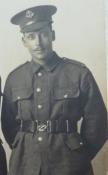
|
The King's School Canterbury |
Roll of Honour |
| 2nd Lieutenant William Frederic BURGESS | |
|
2nd Battalion Suffolk Regiment Date of birth: 19th February 1890 Date of death: 18th August 1916 Killed in action aged 26 Commemorated on the Thiepval Memorial Pier and Face 1C and 2A |

|
| He was born at Panchgani, Bombay in India on the 19th of February 1890 the son of the Reverend Edward Simeon Burgess, later Curate of Pakenham, and Elizabeth (nee Gibson) of 6 Windermere Road, Bournemouth and of Fish Hoek, Central Province in South Africa. He was christened at Panchgani, on the 6th of April 1890. He was educated at the Junior King's School from September 1898 to April 1899. He enlisted as Private 1334 in the Middlesex Regiment before being commissioned as a 2nd Lieutenant in the Suffolk Regiment on the 13th of June 1915; he was posted to the 10th (Reserve) Battalion of his regiment. He embarked for France on the 27th of July 1916 and was one of seven officers who joined the 2nd Battalion of his regiment in the field at Mericourt on the Somme on the 1st of August 1916 to replace the heavy losses the battalion had suffered during the July offensive. At 3pm on the 14th of August 1916 the 2nd Battalion Suffolk Regiment began to move forward to the front line in preparation for an attack the following day. During their march they came under artillery fire near the Bois de Talus and suffered fifteen casualties. They completed the relief of the 10th Liverpool Scottish in Shute Trench and Assembly Trench by midnight and immediately began work on improving their trenches, which were only shoulder deep in places. They spent the day of the 15th of August continuing to improve their positions as well as carrying up supplies and evacuating their wounded. Patrols were sent out that night in order to locate an enemy position which was reported to be one hundred yards in front of them. On the 16th of August they received orders to make an attack in support of the French 2nd Battalion, 418th Regiment and were deployed with Z and Y Companies in the first line trench, with X Company in the second line and with W Company in reserve. The men were to move forward in waves, fifty yards apart with each company advancing on a one hundred and eighty front. At 5.30pm the battalion began their advance under the cover of a supporting artillery barrage but soon came under machine gun fire. Z Company, on the left of the attack, managed an advance of one hundred and twenty yards before all their officers had been killed or wounded with ninety other ranks becoming casualties. The survivors took cover in shell holes where they spent the remainder of the day until withdrawing to their start line later in the day. Y Company took their first objective but losses were also heavy and they too were forced to seek shelter in Cochrane Alley having suffered casualties of eighty six officers and men. They had captured six of the enemy and gained around two hundred and fifty yards of ground by the end of the day. The 17th of August was spent reorganising and consolidating the ground gained as well as by sniping at the Germans who were being forced out of their dug outs by British artillery fire. During the evening on Company was sent forward to support an attack which was to be made by the 10th Battalion Royal Welsh Fusiliers. The attack was made in darkness in the early hours of the 18th of August 1916 but the white tapes which had been laid to guide the attacking parties had been carried away by shell fire and the attack was a failure. That afternoon two companies from the battalion were in action from Cochrane Alley when they fired their rifles and machine gun in support of an attack by the 1st Battalion Gordon Highlanders which was a further attempt to capture the ground which had not been taken on the 16th of August. The Gordons were successful in their attack which brought down a storm of retaliatory German 5.9 artillery fire on Cochrane Alley, causing still more casualties among the Suffolks. William Burgess was posted as missing during the day. The battalion was relieved by a battalion of the Royal Fusiliers during that night and in the early morning of the following day. The survivors marched back to Happy Valley, having lost two hundred and eighty one officers and men during their time in the front line. His brother, Sergeant John Lionel Burgess Croix de Guerre, 14th Reserve of Cavalry attached to the Nigeria Regiment, was killed in action on the 5th of June 1915. He is commemorated on the war memorial at Pakenham in Suffolk but is not currently commemorated on the memorial at the King's School Canterbury. |
|
| Junior King's School |
Back